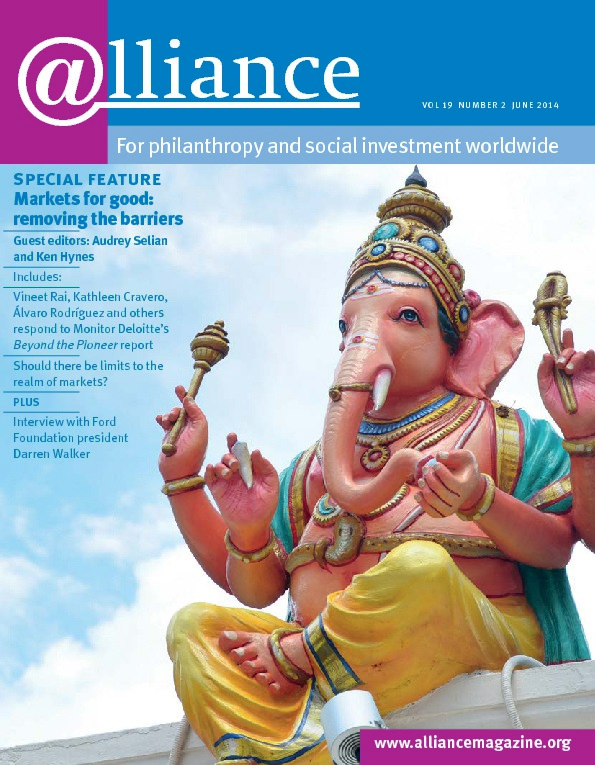I would like to congratulate the authors of Beyond the Pioneer on their courage in addressing the toughest issue in building businesses that serve the base of the pyramid – scale. They mention that most models to benefit the poor are still operating at low levels of scale. No question this is partly because of the high sector ecosystem risk (or ‘barriers to scaling’ as the authors call it). But I think the main reason is the lack of strict business discipline and savvy business practices, as much among the entrepreneurs looking to develop market-based solutions for social problems as among the investors as well as us, the fund managers and those involved in the ‘impact’ sector.
This lack of business discipline arises partly because those looking to develop market-based solutions for social problems usually come from the social sector – and most of them went into that sector in the first place because they felt antagonistic to business. If we want to develop market-based solutions for social problems, we cannot think that because we are doing good, we don’t need disciplined business practices.
Business discipline typically involves hard decisions, such as firing people. If you think with your social rather than your commercial ‘mind’, that’s hard to do. Not making those decisions, however, hurts your business and therefore the possibilities to scale.
Business risk and sector ecosystem risk
IGNIA has always believed that impact comes at the industry level and not necessarily at the firm level. So I am happy that the authors have integrated this concept in their report, the main focus of which is not business risk but sector ecosystem risk – and that is also the focus of this article.
In 2011, during IGNIA’s Annual LP Meeting, we made a presentation to our investors[1] where we introduced our framework for investment analysis. This framework (diagram below) incorporated two dimensions of risk: business risk and sector ecosystem risk.
 We said that investing usually looks only at business risk, but success in investing at the base of the pyramid would come only if you can move a project along both dimensions. We used the following example to explain this.
We said that investing usually looks only at business risk, but success in investing at the base of the pyramid would come only if you can move a project along both dimensions. We used the following example to explain this.
Imagine you are in the trucking business and your trucks always arrive on time, they are the most efficient, you have the best customer service, you have the lowest accident rate, good pricing, etc. So you have been successful at reducing the business risk. But then imagine that there are no roads or the access to roads is limited, then the sector ecosystem risk is high. In order to have a successful business, you will need to mobilize the appropriate players in the ecosystem to get the roads built or to get access to them.
This is what we constantly face at the base of the pyramid – great business opportunities with a lack of infrastructure (using a wide definition of infrastructure which is not only physical), therefore with a high sector ecosystem risk.
The authors introduce the concept of ‘barriers to scaling’ and have accurately broken it down into value chain, public goods and government risks. I welcome more voices drawing attention to this dimension when investing at the base of the pyramid.
The importance of facilitation
Facilitation is what we do all day at IGNIA. We believe, as the authors point out, that entrepreneurs should be well prepared to deal with business risk (establishing this is a crucial element of your due diligence as an investor) but are often badly equipped to deal with sector ecosystem risk. As fund managers, the value that IGNIA offers investors and entrepreneurs is our ability to deal with sector ecosystem risk.
One example was with Mexvi, a business that provides housing for families living in rural or semi-urban areas. When we invested in Mexvi, not a single firm provided long-term financing to enable families to buy these homes. After working with the Mexican government for 18 months, we facilitated the creation of a programme to fund microfinance institutions to provide long-term ‘non-mortgage’ housing loans. Today there are 14 financial institutions offering this product and there is a growing industry offering housing in rural and semi-urban areas.
 Another example was Barared, which wanted to transform independent corner ‘mom & pop’ shops in the slums of Mexico City into bank branches – something not permitted under existing regulations. IGNIA worked with Mexico’s Securities and Exchange Commission for almost two years, as a result of which Barared became the first corresponding banking administrator in the country. IGNIA also facilitated an agreement for Barared to act as Banamex’s (Mexico’s second-largest bank) bank correspondent. Today the authorities have climbed the learning curve and many other competitors are trying to do the same. (Pictured: Barared booth with tablet to perform self-service bank transactions.)
Another example was Barared, which wanted to transform independent corner ‘mom & pop’ shops in the slums of Mexico City into bank branches – something not permitted under existing regulations. IGNIA worked with Mexico’s Securities and Exchange Commission for almost two years, as a result of which Barared became the first corresponding banking administrator in the country. IGNIA also facilitated an agreement for Barared to act as Banamex’s (Mexico’s second-largest bank) bank correspondent. Today the authorities have climbed the learning curve and many other competitors are trying to do the same. (Pictured: Barared booth with tablet to perform self-service bank transactions.)
Who should act as facilitators?
The authors raise the question of which organizations are best positioned to act as ‘facilitators’. I believe the answer is local investors (specifically professional fund managers), provided the fund management team has the necessary access and skills. Managing sector ecosystem risk commonly involves dealing with the government or large corporations, which usually takes much more time and effort than expected. Most fund managers see their investments as their own children and their success is 100 per cent dependent on the success of their investments; they may thus be the only ones prepared to go through the excruciating pain involved in reducing sector ecosystem risk. As the report suggests, industry associations can be key allies here.
The importance of being local cannot be over-emphasized. When we raised IGNIA’s first fund, we had a mandate to invest across Latin America. We soon realized that in order to deal with the sector ecosystem risk of our portfolio companies we needed to be local; we therefore decided to focus on Mexico. I think one of the main flaws of the impact investing sector is that most investors are based in cities that are far from where they invest. How can you act as a ‘facilitator’ when you are based in Switzerland and invest in Kenya – unless of course you have some local presence? There is not a single investment firm in the world that has been successful at investing in traditional early-stage businesses (venture capital) from far away. Respected venture capitalists will do offshore investments only if they have a local trusted co-investor or a local office with senior presence. Somehow in the ‘impact’ sector we think that this rule does not apply to us just because we are doing good – yet another instance of the sector’s lack of business discipline.
Who should pay for facilitation?
The authors point out that ‘industry facilitation requires substantial amounts of money’ and ask who should pay for it, given that individual firms usually do not have the resources to do so? This is a challenge we have faced at IGNIA – and it is a huge challenge.
Unfortunately the development space continues to fall into the trap of only supporting efforts that are not-for-profit, even when a for-profit initiative might be creating a public good (as the authors define it). This has led to the inefficient alternative of creating not-for-profit vehicles: if you depend on a not-for-profit vehicle to make your model successful, your business will not be replicable. This defeats the purpose of industry creation, the level at which true impact will be achieved. It can also create some issues in the DNA of the company that will eventually become an obstacle when trying to scale.
The same considerations apply to philanthropic support for innovation. Innovation, by definition, takes place at the early stage of the firm. The authors refer back to their report From Blueprint to Scale and note that only six of the 84 funds investing across regions offer truly early-stage capital. This is where the system is completely broken today. As the authors point out, ‘pioneer firms are being starved of the right capital’. Where I disagree with the authors is in their view that this ‘right capital’ will come from philanthropy. Venture capital has never needed this early-stage risk capital from philanthropy.
I understand that if you are sitting at your desk in a developed country and you are being asked to make an investment in, for example, Mexico, you become tremendously risk-averse – people in the developed world continue to think that in Mexico we are permanently ducking bullets. In order to bridge this ‘risk gap’, we need more local investors, not only to act as facilitators but also to be able to assess the local risks and invest in the early stages where the innovation takes place. The challenge is that the capital is in the developed world.
Public good or competitive advantage?
One aspect of the problem of paying for facilitation, according to the report authors, is that the public good is enjoyed by the whole industry, so no single firm has an incentive to try to break a barrier to scaling with a public good (eg by getting the government to build roads for the trucking industry).
 We have a different perspective. In the Mexvi case, the government programme to provide long-term ‘non-mortgage’ housing loans that we worked hard for is enjoyed by many of Mexvi’s competitors. We didn’t do this from sheer altruism, but because we believe that the creation of an industry expands the market. McDonald’s was a pioneer in the fast-food business. With the proliferation of fast-food outlets the market has expanded, and McDonald’s has benefited from that expansion. In the base of the pyramid as in any other market, new competitors will arise, an industry will be created and a ‘survival of the fittest’ dynamic will exist – welcome to the market economy! (Pictured: Mexvi housing)
We have a different perspective. In the Mexvi case, the government programme to provide long-term ‘non-mortgage’ housing loans that we worked hard for is enjoyed by many of Mexvi’s competitors. We didn’t do this from sheer altruism, but because we believe that the creation of an industry expands the market. McDonald’s was a pioneer in the fast-food business. With the proliferation of fast-food outlets the market has expanded, and McDonald’s has benefited from that expansion. In the base of the pyramid as in any other market, new competitors will arise, an industry will be created and a ‘survival of the fittest’ dynamic will exist – welcome to the market economy! (Pictured: Mexvi housing)
Also, when you are the one that facilitates the breaking of a barrier to scale, you have a first mover advantage in the market. Barared was the first banking correspondent administrator in Mexico, and this has given the company an important edge over its competitors.
When we talk about investing in the base of the pyramid or investing with impact, we continue to think differently from most businesspeople. In fact I think this discussion of the challenge of developing a public good is foreign to most businesses. Trucking companies lobby all the time for better roads. Why do that if better roads will benefit everyone? Because it makes business sense. Why did PayPal lobby for better regulation of payments over the internet, thus creating an industry and benefiting anyone else that wanted to do the same? Because it makes business sense. Those investing with an impact motive need to start thinking and acting more like businesspeople.
The authors rightly say that the base of the pyramid is less understood than the top of the pyramid; they then suggest – wrongly, in my view – that if you develop this knowledge it’s a ‘public good’. I believe that it is in fact a competitive advantage. At IGNIA, we have been approached by strategic investors wanting to buy one of our portfolio companies precisely because they wanted to buy such knowledge. Part of the value being created is market knowledge.
Seeing the world as it is
The authors talk about ‘products that the poor should buy because it would improve their lives significantly, but they do not readily demand’. This is one of the impact sector’s biggest traps.[2] Most entrepreneurs who want to achieve impact envision a ‘better world’, which pushes them to think of business models where there is no current demand. Their idealism makes them think in terms of what they see as good for poor people, not what poor people want.
The problem is that a business addressing a non-existent current demand (the authors accurately call them ‘push products’) has to change consumer behaviour, and this is one of the hardest things to do. Some of the world’s most successful businesses (Apple is an example) have managed to change how or what we consume, but this involves very high risk. Because most entrepreneurs who want to have positive impact are, by definition, idealists, in the impact world you find a much greater percentage of businesses taking this type of risk. This is simply way too much risk – our chart would need a third dimension for the risk of changing consumer behaviour – and gives businesses a very low probability of success.
The good news is that there are immense opportunities to develop business models that benefit the poor without having to change consumer behaviour. One of the greatest areas of opportunity is simply to offer a better value proposition to a basic product or service that poor people already consume such as water, housing, education or healthcare.
Opportunities in Latin America
Latin America provides particularly good opportunities. In most of the developing world, 80 per cent of the population makes $8 per day or less. In the entire developing world, except Latin America, out of this 80 per cent, 80 per cent make $2 a day or less and the remainder make between $2 and $8 a day. Latin America is the other way around: 80 per cent make between $2 and $8 a day, the remainder $2 a day or less. This creates a completely different dynamic for the base of the pyramid in Latin America: you have a much larger market that, even though it is still poor, has sufficient purchasing power to be a true addressable market to develop viable and scalable business models. It is no coincidence that the region where commercial microfinance has been most successful is Latin America.
1 Omidyar Network, JP Morgan, Rockefeller Foundation, MIF, Soros Economic Development Fund, among others.
2 We fell for this trap in the early days of IGNIA. We invested in a primary healthcare company because we thought that the poor would want to receive preventive healthcare services to be healthier and thus reduce their healthcare costs – it is completely rational. The company shut down 18 months ago.
Álvaro Rodríguez Arregui is co-founder and managing partner of IGNIA. Email ara@ignia.mx
InvestAmericas: building a stronger ecosystem for SMEs in Latin America and the Caribbean
The Inter-American Investment Corporation (IIC) will launch the InvestAmericas network in the third quarter of 2014. The goal is to support economic growth in Latin America and the Caribbean by increasing the flow of investment capital to SMEs in the region. To that end, InvestAmericas will bring together four key stakeholder groups: (1) SMEs, (2) investors, (3) third party service providers (eg due diligence providers) and (4) business support organizations (eg incubators and accelerators).
The network will be supported by an online platform designed to reduce the high transaction costs associated with SME investments. Through this platform investors will have access to a pipeline of SME investment opportunities drawn from the IIC’s 26 member countries as well as a vast array of service providers that can help them with the due diligence and ‘paperwork’ should they choose to invest.
Recognizing that ecosystems are complex and unpredictable, the IIC believes a social network approach is the most effective means of generating the trust, knowledge sharing, collaboration and programmatic flexibility required to overcome the many barriers that drive up transaction costs between investors and SMEs. The IIC is well positioned to play the role of facilitator in this regard given the technical expertise and goodwill that it has accumulated in the region since its establishment over 25 years ago. The IIC is a member of the Inter-American Development Bank Group. The network will be developed in collaboration with Artha Networks Inc.
For more information
http://www.investamericas.com







Comments (0)